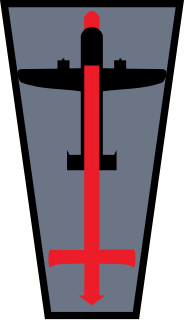Related Research Articles
The Robin Hood Battalion was a unit of the Volunteer Force of the British Army and Territorial Force, later the Territorial Army. The battalion served as infantry on the Western Front during World War I. In the 1930s it re-roled as an anti-aircraft unit and served in World War II, including North-western Europe from June 1944 to May 1945.
The 109th Division was an infantry division of the Imperial Japanese Army. Its call sign was the Courage Division. It was formed on 24 August 1937 in Kanazawa as a square division, simultaneously with the 108th division. The nucleus for the formation was the 9th division headquarters. It was subordinated from the beginning to the Japanese Northern China Area Army.
The Order of Lenin Moscow Air Defence District was a formation of the Soviet Air Defence Forces and the Russian Air Defence Forces, which existed from 1954 to 1998, to fulfill the tasks of anti-aircraft defense of administrative and economic facilities. The district administration was in Moscow.
1st Anti-Aircraft Brigade was an Air Defence formation of the British Army in World War II that served in the Battle of France and The Blitz. It then transferred in the Middle East, where it defended Eighth Army's lines of communication in the final phases of the North African Campaign.

The 1st Anti-Aircraft Division was an Air Defence formation of the British Army before and during the early years of World War II. It defended London during the Battle of Britain and The Blitz.
27th Anti-Aircraft Brigade was an Air Defence formation of the British Army in World War II that served in The Blitz and later converted to infantry.
26th (London) Anti-Aircraft Brigade was an Air Defence formation of the British Army during World War II. It defended London during the Blitz.

The 36th (Middlesex) Searchlight Regiment was a volunteer air defence battalion of Britain's Territorial Army (TA) from 1936 until 1961, at first as part of the Royal Engineers, later in the Royal Artillery. As part of 40th Anti-Aircraft Brigade it defended air bases in East Anglia through the Battle of Britain and the Blitz. Towards the end of 1944 the unit underwent infantry training, serving briefly in Norway at the end of the war. After the war, the 36th continued as a TA unit, with some women serving with it. In 1961, the remnants of the regiment amalgamated with others to form a combined infantry battalion, and all links with air defence were severed.
The 29th (Kent) Searchlight Regiment was a volunteer air defence unit of Britain's Territorial Army (TA) from 1935 until 1955, at first as part of the Royal Engineers (RE), later in the Royal Artillery (RA). It served during The Blitz, defended South West England and the Orkneys and Shetlands before becoming garrison troops in North West Europe.
30th (Surrey) Searchlight Regiment was an air defence unit of Britain's Territorial Army from 1924 until 1961. During World War II it served in The Blitz and later in the Tunisian and Italian Campaigns, while detachments from the regiment served in the Far East and were captured at the Fall of Singapore.
The 32nd (Midland) Anti-Aircraft Brigade was an air defence formation of Anti-Aircraft Command in Britain's Territorial Army (TA) from 1936 to 1955, charged with defending the East Midlands of England.
58th (Middlesex) Searchlight Regiment, Royal Artillery was an air defence unit of Britain's Territorial Army (TA) raised just before World War II. It defended the East Midlands of England during The Blitz, and later served as infantry in North West Europe at the end of the war, converting to the anti-aircraft (AA) artillery role postwar.
The Essex (Fortress) Royal Engineers was a volunteer unit of Britain's Royal Engineers formed to defend the Essex coast. It served in this role in World War I and then converted to a searchlight regiment for air defence in World War II. The unit ended the war as a garrison infantry battalion. Its descendants continued to serve in the Territorial Army until 1955.

70th (Sussex) Searchlight Regiment Royal Artillery was an air defence unit of Britain's Territorial Army (TA) raised just before the outbreak of World War II, which served as part of Anti-Aircraft Command during and after the war.

75th (Middlesex) Searchlight Regiment, Royal Artillery was an air defence unit of Britain's Territorial Army (TA) raised just before the outbreak of World War II and served as part of Anti-Aircraft Command in the early part of the war. Later, it changed role and served in Sicily and Italy, and reformed in AA Command after the war.
The 344th Moonlight Battery, Royal Artillery was a searchlight unit of the British Army that provided artificial illumination, or 'Monty's Moonlight', for night operations by 21st Army Group during the campaign in North West Europe in 1944–45. Previously, it had served on anti-aircraft (AA) duties during The Blitz.
The Imperial Japanese Army (IJA) established several shipping artillery units during the Pacific War. These units provided defensive guns and gun crews for the transport ships operated by the Army, as well as merchant vessels chartered by the service.
An Anti-Aircraft Artillery Division was a type of Anti-aircraft unit of the Soviet Union's Red Army, Soviet Army, and the Soviet Air Defense Forces (PVO) during World War II and the early years of the Cold War.
The 2nd Guards Anti-Aircraft Artillery Division was an anti-aircraft artillery division of the Soviet Union's Red Army during World War II and the Soviet Army during the early years of the Cold War.
References
- Citations
- Works consulted
- Ness, Leland S. (2014). Rikugun: Guide to Japanese Ground Forces, 1937–1945. Volume 1: Tactical Organization of Imperial Japanese Army & Navy Ground Forces. Solihull, United Kingdom: Helion. ISBN 9781909982000.
- Zaloga, Steven J. (2010). Defense of Japan 1945. Oxford: Osprey Publishing. ISBN 1-84603-687-9.